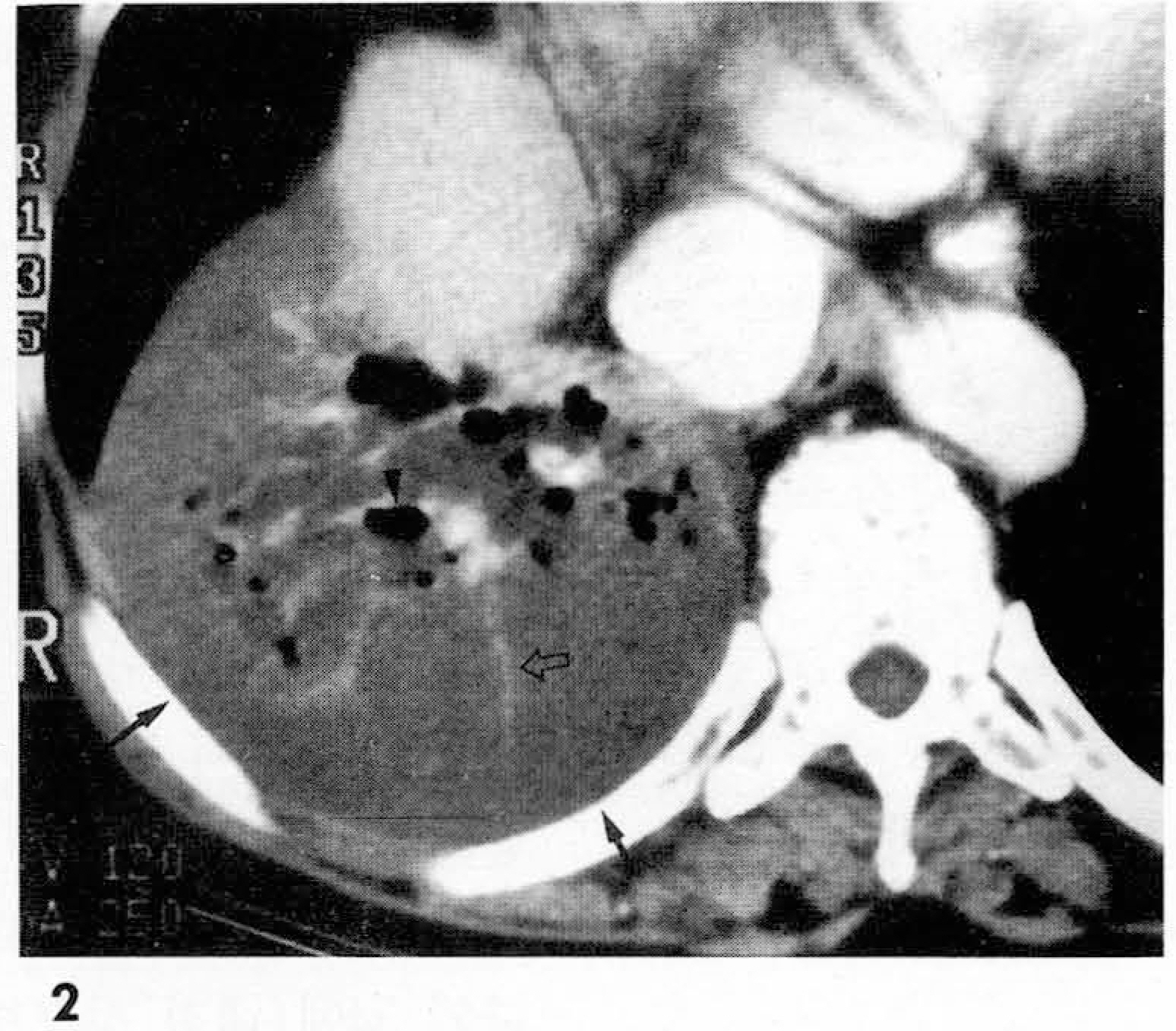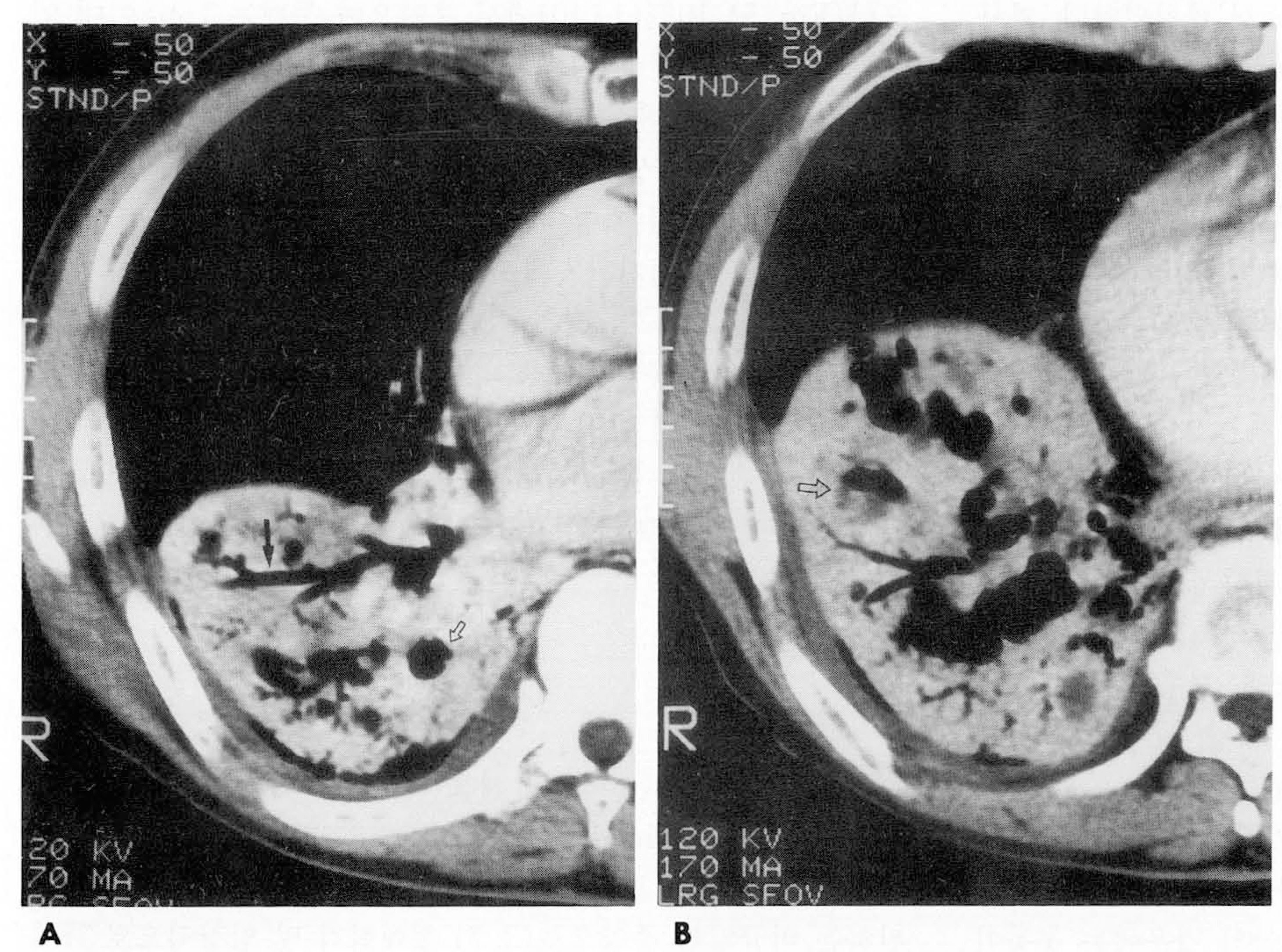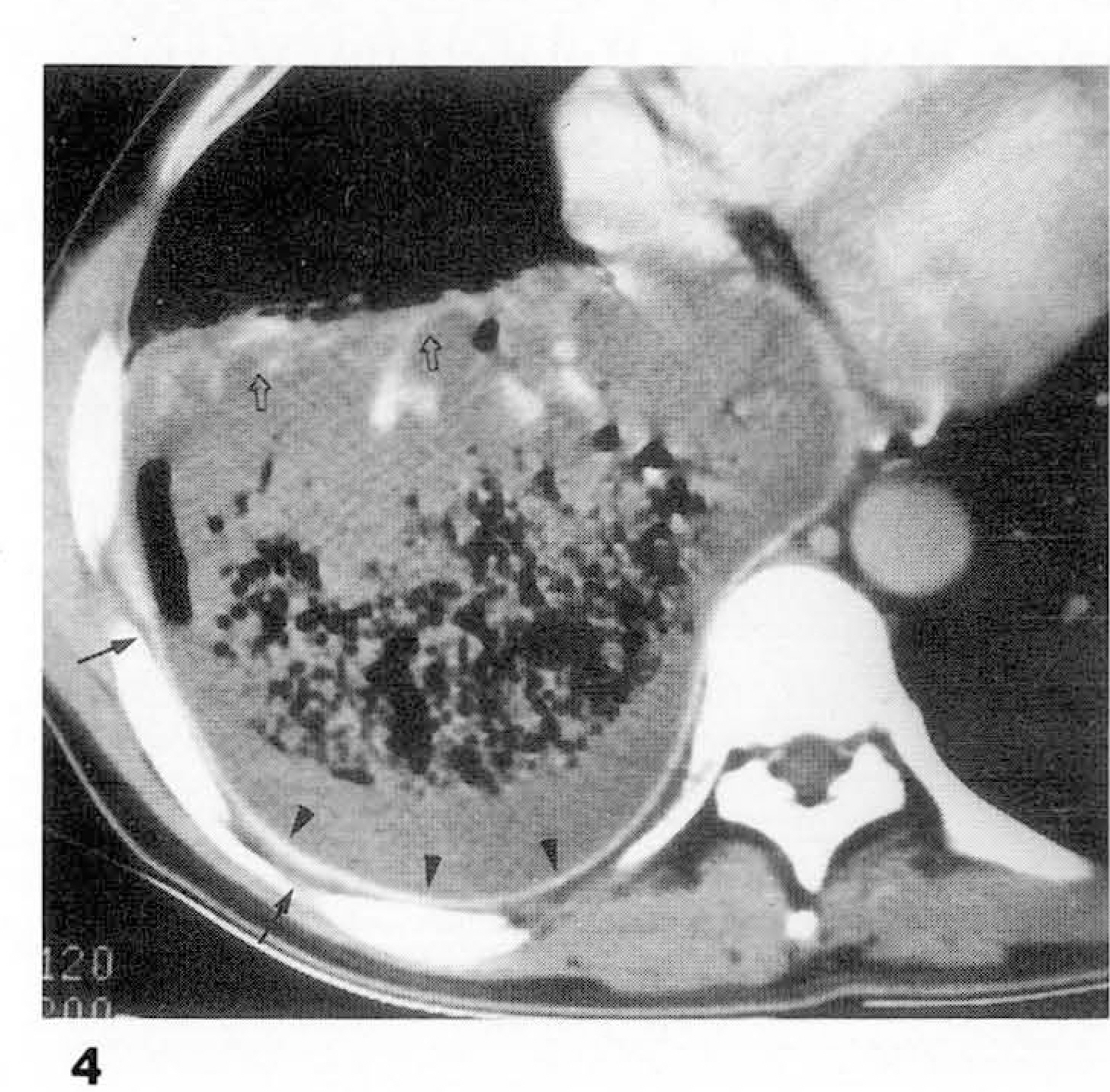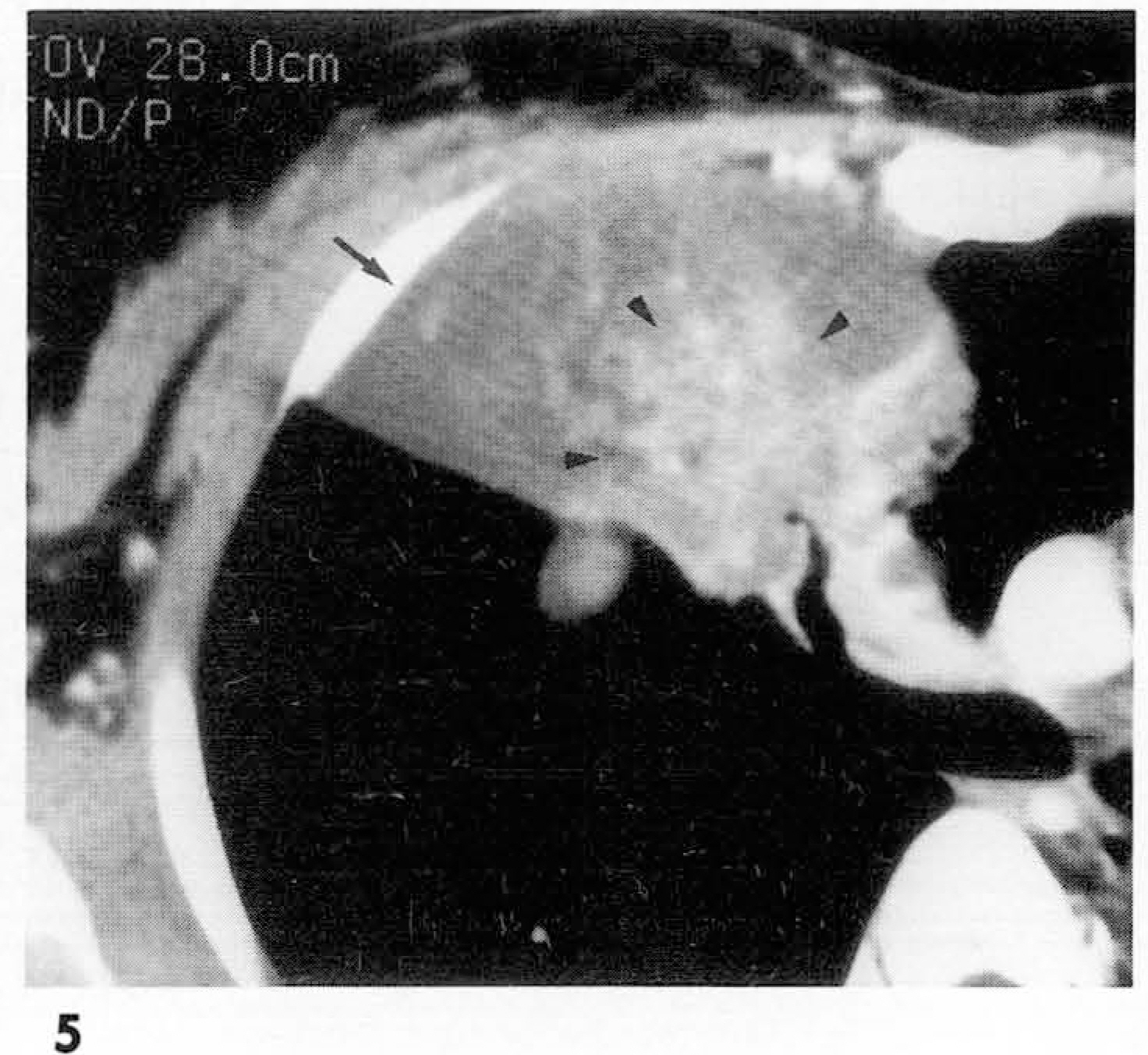J Korean Radiol Soc.
1998 Mar;38(3):465-471. 10.3348/jkrs.1998.38.3.465.
Consolidation Type of Bronchioloalveolar Carcinoma and Necrotizing Pneumonia: Differential Diagnosis on CTScans
- Affiliations
-
- 1Department of Radiology, Chungnam National University Collage of Medicine.
- 2Department of Radiology, Eulji Medical Collage Taejon Hospital.
- 3Department of Internal Medicine, Catholic University Collage of Medicine.
- 4Department of Radiology, Eulji Medical Collage Nowon Hospital.
- KMID: 2201403
- DOI: http://doi.org/10.3348/jkrs.1998.38.3.465
Abstract
-
PURPOSE: To determine the CT findings which distinguish consolidation-type bronchioloalveolar carcinoma fromnecrotizing pneumonia.
MATERIALS AND METHOD: This study involved ten patients with pathologically-provenconsolidation-type bronchioloalveolar carcinoma and 34 with necrotizing pneumonia proven pathologically either inthe laboratory or clinically. We retrospectively analyzed CT features including the enhancement pattern ofconsolidated lung, the presence and internal density of cavity within consolidated lung, CT angiogram sign,air-bronchogram, pleural enhancement, pleural effusion, and change in extrapleural tissue and its density.
RESULT: CT findings in patients with necrotizing pneumonia showed higher attenuation in marginal (94.1%) and inner(85.3%) portions in consolidated lung than in muscles (p<0.005); the presence of cavity (91.2%, p<0.05) ; cavitywith fluid or air-fluid level (77.4%, p<0.005); pleural enhancement (88.2%, p<0.00003) ; pleural effusion (33.3%,p<0.05); and change in extrapleural tissue (64.7%, p<0.05). CT findings in patients with consolidation-typebronchioloalveolar carcinoma showed lower attenuation in marginal (90.0%) and inner (60.0%) portions ofconsolidated lung than muscles (p<0.005) and of cavity containing air (100%; p<0.005). However, air-bronchogramand CT angiogram signs were not helpful in differentiating the two groups.
CONCLUSION
CT can help differentiateconsolidation-type bronchioloalveolar carcinoma and necrotizing pneumonia.
Keyword
MeSH Terms
Figure
Reference
-
1.Epstein DM. Bronchioloalveolar carcinoma. Semin Roentgenol. 1990. 25:105–111.
Article2.Hill CA. Bronchoalveolar carcinoma: a review. Radiology. 1984. 150:15–20.3.Im JG., Han MC., Yu ΕJ, et al. Lobar bronchoalveolar carcinoma: “Angiogram Sign” on CT scan. Radiology. 1990. 176:749–753.4.Epstein DM., Gefter WB., Miller WT. Lobar bronchioloalveolar cell carcinoma. AJR. 1982. 139:463–468.
Article5.Jang HJ., Lee KS., Kwon OJ., Rhee CH., Shim YM., Han JG. Bronchioloalveolar carcinoma: focal area of ground-glass attenuation at thin-Section CT as an early sign. Radiology. 1996. 199:485–488.
Article6.Alder B., Padley S., Miller RR., Muller NL. High-resolution CT of bronchoalveolar carcinoma. AJR. 1992. 159:275–277.7.Wong JSL., Weisbrod GL., Chamberlain D., Herman SJ. Bronchioloalveolar carcinoma and the air bronchogram sign: a new pathologic explanation. J Thorac Imaging. 1994. 9:141–144.8.손홍주, 김상진. 세기관지폐포암종의폐전산화단층촬영소견. 대한방사선의학희지. 1995. 32:717–723.9.Naidich DP., Zerhouni EA., Siegelman SS. Computed tomography and magnetic resonance of the thorax. 2nd ed.New York: Raven Press;1991. ;423-427.10.박홍석, 임정기, 유재욱, 연경모, 한만청. 괴사성폐렴: 전산화단층촬영및임상적의의. 대한방사선의학회지. 1995. 33:875–881.11.Im JG., Webb WR., Rosen A., Gamsu G. Costal pleura: appearances at high-resolution CT. Radiology. 1989. 171:125–131.
Article12.Thurlbeck WM. Pathology of the lung. 2nd ed.New York: Thieme;1995. ;458-463.13.Kuhlman JE., Fishman EK., Kuhajda FP, et al. Solitary bronchoalveolar carcinoma: CT criteria. Radiology. 1988. 167:379–382.14.Im JG., Choi BI., Park JH, et al. CT finding of lobar bronchoalveolar carcinoma. J Comput Assist Tomogr. 1986. 10:320–322.15.Bartlett JG., Finegold SM. Anaerobic pleuropulmonary infections. Medicine. 1972. 51:413–449.
Article16.Moon WK., Im JG., Yeon KM., Han MC. Complication of Klebsiella pneumonia: CT evaluation. J Comput Assist Tomogr. 1995. 19:176–181.17.Murayama S., Onitsuka H., Murakami J., Torii Y., Masuda K., Nishihara K. “CT Angiogram Sign” in obstructive pneumonitis and pneumonia. J Comput Assist Tomogr. 1993. 17:609–612.
Article18.Weisbrod GL., Towers Μ J., Chamberlain DW., Herman SJ., Matzinger FRK. Thin-walled cystic lesions in bronchoalveolar carcinoma. Radiology. 1992. 185:401–405.19.Zwirewich CV., Vefal S., Miller RR., Muller NL. Solitary pulmonary nodule: high-resolution CT and radiologic-pathologic correlation. Radiology. 1991. 179:469–476.
Article20.Shapiro R., Wilson GL., Yesner R., Shuman H. A useful rentgen sign in the diagnosis of localized bronchioloalveolar carcinoma. AJR. 1971. 114:516–524.21.강은영, 이민진, 정규병. 세기관지폐포암의방사선학적소견. 대한방사선의학희지. 1992. 28:89–94.22.김성진, 임정기, 박길선, 김학수, 한만청. Malignant vs benign pleural lesion: CT findings. 대한방사선의학회지. 1990. 26:735–742.23.Aqunino SL., Webb WR., Gushiken BJ. Pleural exudates and transudates: diagnosis with contrast-enhanced CT. Radiology. 1994. 192:803–808.
Article24.Waite RJ., Carboneau RJ., Balikian JP, et al. Parietal pleural changes in empyema: apperances at CT. Radiology. 1990. 26:735–742.
- Full Text Links
- Actions
-
Cited
- CITED
-
- Close
- Share
- Similar articles
-
- Consolidative Bronchioloalveolar Carcinoma Presenting as Pneumonia, and This Led to a Late Diagnosis due to the Improvement after Antibiotic Therapy
- CT Findings of Bronchioloalveolar Carcinoma
- Bronchioloalveolar carcinoma: a variety of radiographic patterns
- CT Findings of Necrotizing Pneumonia
- A case of very slowly progressed pneumonic consolidation







